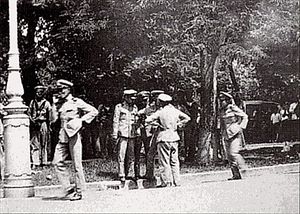For Thailand, June 24 this year marked the 85th anniversary of the 1932 revolution that ended the absolute monarchy. Economic problems as a result of the Great Depression, rapid social changes, and frustration at the privileges enjoyed by the upper class were commonly listed as reasons that led to the revolution. Arising from the revolution, “Six Principles” were promulgated to reflect goals based on people’s power, national security, economic welfare, rights and liberties, equality, and education for all citizens. The revolution was hailed as the beginning of a democratic Thailand.
The 1932 revolution is such a monumental event that the nation needs to truly embrace its own past in order to move forward in the future. However, the Thai state has been attempting to bury the memory and reduce the historical significance of the revolution. For instance, the state narrative explains that the commoners “revolted” against the King to bring about democracy prematurely, which in turn gave rise to subsequent political instability. This narrative promotes a negative perception of the revolution. Besides the narrative, steps have also been taken to remove historical artifacts connected to the revolution and keep coverage of it vaguely described.
Nevertheless, any effort to conceal the memory of the 1932 revolution is going to be difficult in the information age, where people can gain access to information easily.
One of the many ways the Thai state has attempted to reduce the 1932 revolution’s historical significance was to create a counter-narrative against it. When Field Marshal Sarit Thanarat came to power in 1958 through a self-coup, his regime overthrew the entire political system and values associated with the 1932 revolution. It was claimed that Western political concepts and values were incompatible with Thai traditions and values. Therefore, Sarit had to revive a “Thai-style” democratic system, where the King was claimed to be an inherent element. In fact, according to this narrative the King’s “benevolent paternalism” meant that he was actually elected.
Another way in which the Thai state went about attaching little importance to the revolution was to stop celebrating June 24 as the country’s National Day. Sarit changed the date of National Day to King Bhumibol Adulyadej’s birthday as a sign that the state’s interests had successfully overcome the brief interregnum caused by the “revolt” of the commoners. Gradually, the 1932 revolution would be forgotten.
The Thai state would not have been successful in this effort if not for King Bhumibol’s charisma and popularity. The Thai state was able to use the late King’s dedication to his people as a sharp contrast to the corrupt nature of politicians. Thus, it helped the Thai state to reinforce the perception that Western democracy was not suitable for Thailand in order to downplay the significance of the 1932 revolution.
The Thai state has also made sure that the 1932 revolution is kept vaguely described in the schools’ history curriculum. The vagueness leaves lessons of the 1932 revolution to the discretion of the teachers. If the teachers are afraid to provide a balanced view of the revolution, as it may conflict with state narrative, students are unlikely to hear the full story. In other words, the history behind the 1932 revolution and how it connects with the present will not be critically discussed in classes.
Another small but nevertheless significant way in which the Thai state obscures the symbolism of the 1932 revolution is to demolish or remove historical artifacts related to it. First, the Supreme Court Building, which once stood for modern Thailand, was demolished to make way for a new building with no historical links to the revolution. Second, a plaque commemorating the revolution mysteriously vanished in April this year. The case of the missing plaque was nothing new, as it was removed during Sarit’s era only to be restored after his death. But as it can be seen, there were multiple attempts to obscure the symbolism and bury the memory of the 1932 revolution.
Even so, it will not be easy to effectively conceal the memory of the 1932 revolution. The case of the missing plaque, in particular, has sparked an unprecedented debate on social media about the 1932 revolution and the system of absolute monarchy. Prior to the commemorative plaque going missing, many younger Thais would not have been aware of the existence of the plaque embedded on Royal Plaza ground in 1936. However, as a result of the debate on social media, many younger Thais have come to know not only about the commemorative plaque, but also about the 1932 revolution, its legacy, and the values it stood for.
We live in an information age; the state no longer has a monopoly over the information consumed by its own citizens. As much as the Thai state would like to restrict coverage of the 1932 revolution, such efforts would leave many younger Thais dissatisfied. It would then lead to an unintended consequence: having many younger Thais searching for online books and relying on social media for alternative perspectives. The earlier the Thai state comes to this realization, the better the chances for the nation to grow in maturity and move forward in the future.
Eugene Mark is a senior analyst with Singapore’s S. Rajaratnam School of International Studies. He has a deep interest in Thailand’s political and security affairs.

































